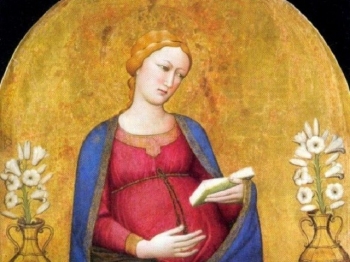Advent Reflections
 The Virgin of Advent, Antonio di Francesco da Venezia (14th century)
The Virgin of Advent, Antonio di Francesco da Venezia (14th century)
The Grand Master of the Order of the Holy Sepulchre, at the request of the Vice Governor for North America, Tom Pogge, recorded a video message in English to the members of the Order living in the United States, to guide them spiritually on the path of preparation for Christmas. The message on Advent can be a support for all of us and that is why, in agreement with Cardinal Filoni, we have chosen to translate the essentials and propose it to our readers in the five languages of the official website of the Grand Magisterium.
Dear friends, Dames and Knights.
When we have an important event in sight, we carefully prepare ourselves paying great heed to every detail, inwardly and outwardly, in the belief that the event is of considerable importance for our life. I would therefore like to invite you to reflect with me on the Season of Advent in the life of the Church, as an important period which demands our close attention.
I thank Vice Governor Tom Pogge for giving me the opportunity to talk about it.
For this brief reflection, I would like to start with a question:
Why is there a period called "Advent" in the Church? What does it mean?
Advent is a time that indicates three things: 1. the beginning of a new liturgical year, corresponding to the present we are living, 2. a memory, that is, of the historical event of the coming of the Lord in the flesh, 3. the eschatological or final wait, in relation to our existence.
With Advent, therefore, the Liturgical Year begins. Over the course of twelve months, the Church proposes to us to live this entire span of time in faith with reference to Christ. Life and faith, in fact, are closely intertwined for the Christian.
Through the Liturgy, which always proclaims the primacy of God, the Church announces and celebrates the mystery of the Redemption and carries out the work of salvation. It is a question of retracing, or rather of reliving with sacred and spiritual actions the short years of the life of the Lord: his incarnation and birth, his teaching and his activity, his passion, death and resurrection; finally, the time when, with Pentecost, the Church was formed and its mission in the world began. All the great mysteries of faith find space and, I would say, life in the liturgical year.
Advent is the first of the so-called 'strong' moments of the liturgical life of the Church, together with Lent, the Easter season and then the Ascension and Pentecost. It is therefore a question of reliving the long wait of the people for the Redemption in the four weeks of Advent. This happens through the reading and meditation of selected passages from Sacred Scripture (which I invite you to read on the internet every day, in the absence of a good liturgical book), in particular by listening to the word of the Prophets and men of God, who had the task of preparing the way for Christ through the experience of the Chosen People and arousing the hope also destined for all peoples. It is a time that is full of prayers, meditations and celebrations that arouse the anticipation and joy that a great event entails.
Furthermore, in Advent it is not only we who prepare ourselves for the encounter with God, but also - so to speak - God Himself who prepares to meet us in the reality of our life, He who is the " The true light that gives light to everyone was coming into the world "(John 1: 9).
We are dealing with two coordinated lines: the horizontal one relating to our preparation for welcoming Christ and the vertical descending one of God who, having entered human history, does not abandon it, is not disinterested in it. The lowering of the Lord that we contemplate in the Incarnation is not over. Blaise Pascal, the philosopher, said that the agony of Jesus continues until the end of time (cf. Thoughts n.736), echoing Saint Paul's teaching that the Son of God, despite his divine condition, did not consider it a privilege to be like God, but emptied himself, assuming the nature of a servant and making himself obedient to death and death on the cross (cf. Phil 2, 6-8). A mystery that continues in the Church.
To accomplish the "emptying", God made use of the human contribution, of a woman, Mary, who will give features to the only-begotten Son of the Father, and of a man, Joseph, who will provide a home. The liturgical feast of the Immaculate Conception, in the middle of Advent, brings to mind the image of the burning bush, which Moses, amazed, saw burning but not consumed and from which a shining flame emanated: Mary was this burning bush of love of God, the bush from which Christ's holy humanity comes.
In conclusion, Advent prepares us for the liturgical and spiritual encounter with the Lord. At the same time, he invites us to reflect on our ultimate encounter with God, when, as the Apostle Paul teaches in the first Letter to the Corinthians, we "shall see face to face. " (1 Cor 13:12).
We must never forget that a Christian's life is a journey that leads to an encounter with the Lord; as pilgrims, prayer, hope and good works accompany us.
Every Dame and Knight always carries with him the lamp of industriousness and vigilance, making his own the Lord's exhortation: " If he comes suddenly, do not let him find you sleeping." (Mk 13:36).
Happy Advent!
Fernando Cardinal Filoni
(December 2020)



